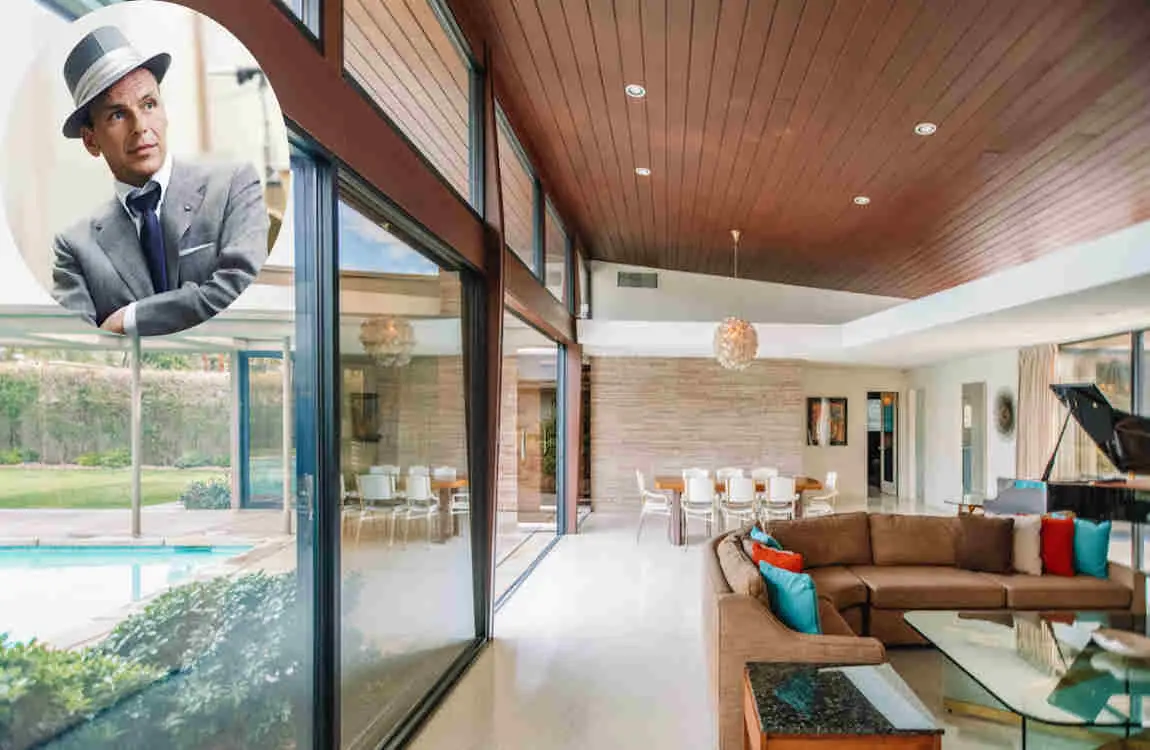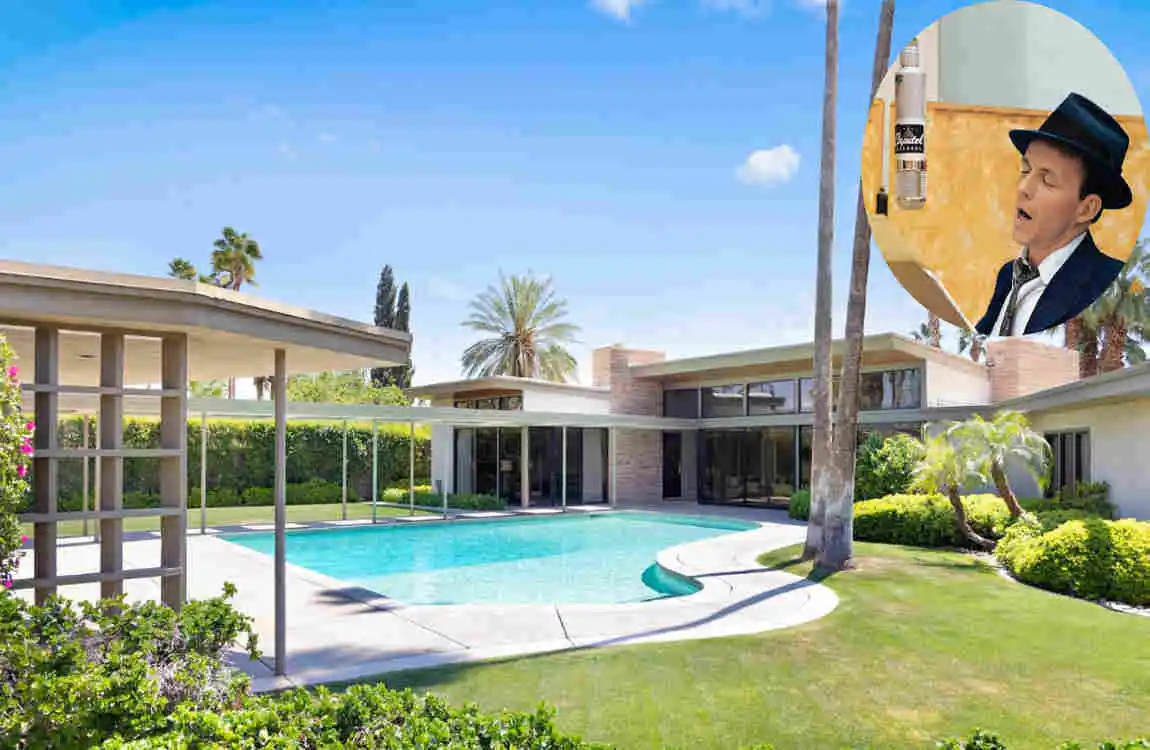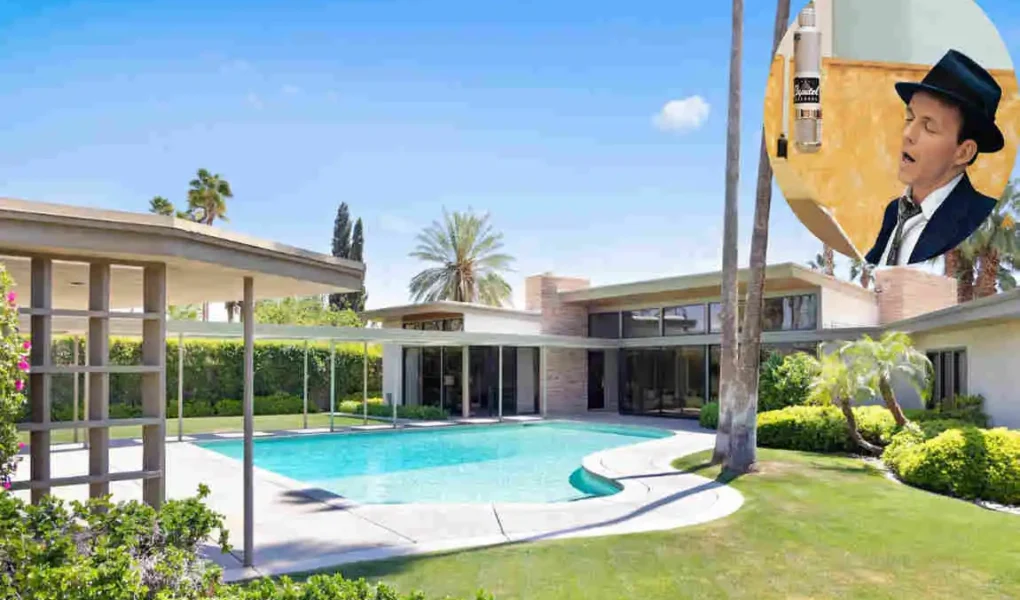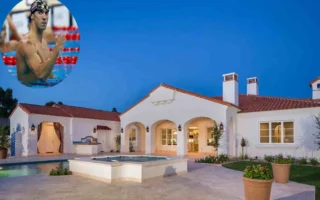Frank Sinatra’s house in Palm Springs, known as the Twin Palms Estate, is unique for its iconic mid-century modern architecture designed by E. Stewart Williams in 1947. It features long horizontal lines, flat planes, floor-to-ceiling glass walls that blend indoor and outdoor living, and an accidental piano-shaped swimming pool. Sinatra’s bedroom is set apart in its own wing for privacy, and the house was a pivotal work that helped launch the Desert Modernism movement in Palm Springs. The estate also includes vintage furnishings, memorabilia, and even a preserved recording studio, making it a rich blend of architectural elegance and Hollywood history. Two tall palm trees in the yard gave the estate its name, and Sinatra famously raised a Jack Daniel’s flag between them to signal cocktail hour to friends.
| Field | Information |
|---|---|
| Full Name | Francis Albert Sinatra |
| Known As | Frank Sinatra |
| Date of Birth | December 12, 1915 |
| Date of Death | May 14, 1998 |
| Birthplace | Hoboken, New Jersey, USA |
| Profession | Singer, Actor, Producer |
| Personality Notes | Enjoyed classical music and opera; workaholic; had mood swings; generous; had FBI surveillance due to alleged Mafia ties |
| Career Highlights | Sold over 150 million records; acted in many films; part of Rat Pack; earned an Academy Award |
| Net Worth at Death | Estimated $200 million (approximately $350 million adjusted for inflation in 2025) |
| Current Residence | Deceased (passed away in 1998 in Los Angeles, California) |
Who is Frank Sinatra?

Frank Sinatra was an American singer and actor, born on 12 December 1915, in Hoboken, New Jersey, to Italian immigrant parents. He was one of the most popular and influential entertainers of the 20th century, known for his smooth vocal style and charismatic performances. It is estimated that Sinatra sold 150 million records worldwide under his nicknames “The Chairman of the Board” and “Ol’ Blue Eyes.” He began his career in the swing era, initially singing with bands led by Harry James and Tommy Dorsey before achieving massive success as a solo artist.
Sinatra’s notable albums include The Voice of Frank Sinatra, In the Wee Small Hours, and Songs for Swingin’ Lovers!. Later, he founded his own label, Reprise Records, and collaborated with other music legends, including Count Basie, Antonio Carlos Jobim, and Duke Ellington. He was also an accomplished actor, winning an Academy Award for Best Supporting Actor for his role in From Here to Eternity. Among Sinatra’s best-known songs are “My Way,” “New York, New York,” and “Strangers in the Night.”
Where Does Frank Sinatra Currently Live?
Frank Sinatra is no longer alive, as he passed away in 1998. During his lifetime, he primarily lived in several residences in California, notably in the Palm Springs area. He lived in the “Villa Maggio” estate in Mountain Center, California, for about 12 years after its construction in 1970. He also owned the “Twin Palms” estate in Palm Springs and a larger compound in Rancho Mirage nearby.
You may also read (daniel negreanus luxurious new house).
The History of Frank Sinatra’s Palm Springs Home
Frank Sinatra’s Palm Springs home, nestled in the desert landscape, was built in 1947. Designed by renowned architect E. Stewart Williams, it became a sanctuary for the legendary singer and actor.
Sinatra purchased the property after his marriage to Ava Gardner. The house quickly transformed into a retreat for the Hollywood elite during its heyday. Its sleek mid-century design reflected Sinatra’s personal style—bold yet sophisticated.
Over the years, this residence hosted countless parties and gatherings filled with music and laughter. Guests included icons like Marilyn Monroe and Dean Martin, solidifying its reputation as a glamorous hotspot.
Design and Architecture of the House
Frank Sinatra’s Palm Springs home, known as Twin Palms, is a striking example of mid-century modern architecture Desing. Designed by renowned architect E. Stewart Williams in 1947, the house embodies elegance and simplicity.
| Attribute | Details |
|---|---|
| House Name | Twin Palms |
| Address | 1148 East Alejo Road, Movie Colony East neighborhood, Palm Springs, California |
| Architecture Design | Mid-century Modern by architect E. Stewart Williams |
| Year Built | 1947 (constructed within months for New Year’s Eve party) |
| Size | Approx. 4,500 sq. ft. |
| Structure | Single story, flat roof except for living/dining room and master suite with shed roofs |
| Rooms | 4 bedrooms, 7 bathrooms |
| Special Features | Piano-shaped pool (legendary but unintentional by architect), canopy skylight entry, pool house with kitchenette and cabana showers |
| Materials | Redwood board and batten siding (original, later replaced with painted cement plaster), Douglas Fir for ceilings, Arizona flagstone chimney stacks |
| Style Highlights | Long horizontal lines, floor-to-ceiling glass walls, blending indoor-outdoor space, desert modernism |
| Notable History | Sinatra originally requested a Georgian style home but chose modern design; house became a hub for Hollywood star gatherings; Sinatra lived here from 1948 to 1957 |
| Architectural Significance | Helped launch Desert Modernism in Palm Springs; propelled E. Stewart Williams’s career |
| Interior Highlights | Vintage furniture, 1950s recording system, upgraded kitchen with Viking appliances |
| Estimated Worth | Historically valued as a mid-century architectural icon, actual price not specified here |
| Cultural Importance | Hosted many celebrity parties, symbol of postwar Hollywood glamour |
The clean lines and open spaces create a seamless flow between indoor and outdoor living. Large glass walls invite natural light while offering stunning views of the surrounding mountains.
Its unique layout features a central courtyard with a pool that serves as the heart of the property. The iconic butterfly roof adds an artistic flair while ensuring efficient ventilation.
Inside, vintage furnishings complement the home’s distinct charm. Earthy tones blend with bold accents, creating an inviting atmosphere that exudes sophistication without pretension.
Special Features and Amenities

Frank Sinatra’s Palm Springs home is a treasure trove of unique features that reflect his glamorous lifestyle. The soaring ceilings and expansive windows create an airy atmosphere, allowing natural light to flood the interior.
One standout element is the grand piano room, where many impromptu jam sessions likely took place. Imagine the melodies echoing through those walls!
The outdoor pool area offers incredible views of the desert landscape. It’s easy to picture Sinatra hosting lavish parties by this sparkling oasis under starry nights.
Celebrity Guests and Iconic Parties at the House
Frank Sinatra’s Palm Springs home was more than just a residence; it was a legendary gathering place for the stars. The likes of Ava Gardner, Marilyn Monroe, and even President John F. Kennedy graced its halls.
Sinatra had an unmatched charisma that drew A-listers from all corners of Hollywood. Parties were extravagant affairs filled with music, laughter, and unforgettable moments under the desert sky.
Current Ownership and Preservation Efforts
Frank Sinatra’s Palm Springs home has a rich legacy that continues to capture the imagination of many. After changing hands several times, it is now privately owned by enthusiasts who cherish its historical significance.
The current owners are dedicated to preserving the original charm and character of the property. They understand the importance of maintaining its architectural integrity while ensuring it remains a tribute to Sinatra’s storied life.
Regular restoration projects focus on keeping key features intact, from the iconic pool area to vintage fixtures throughout the house. These efforts not only honor Sinatra’s memory but also promote an appreciation for mid-century architecture in general.
Impact on Pop Culture and Tourism in Palm Springs
Frank Sinatra’s Palm Springs home has become a cultural landmark. Fans of the legendary singer often visit, drawn by the allure of his glamorous lifestyle.
The house is more than just a residence; it symbolizes an era of Hollywood elegance and charm. Tourists flock to see where some of music’s most significant moments unfolded. The stories behind those walls resonate with nostalgic vibes that continue to attract visitors year after year.
Local tour companies capitalize on this fascination. They offer special packages highlighting Sinatra’s life in Palm Springs, blending music history with real estate intrigue.
Frank Sinatra’s Palm Springs House

You may also read (judge judys luxuriou shome).


